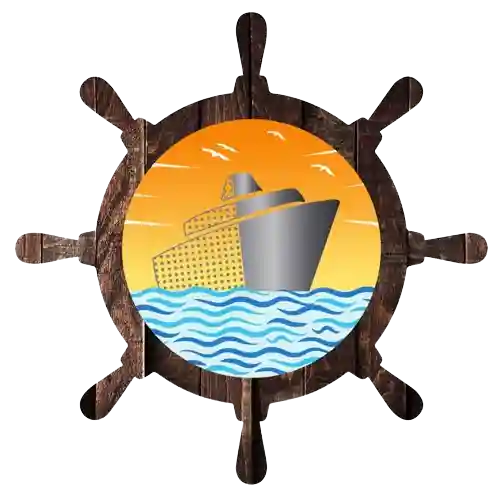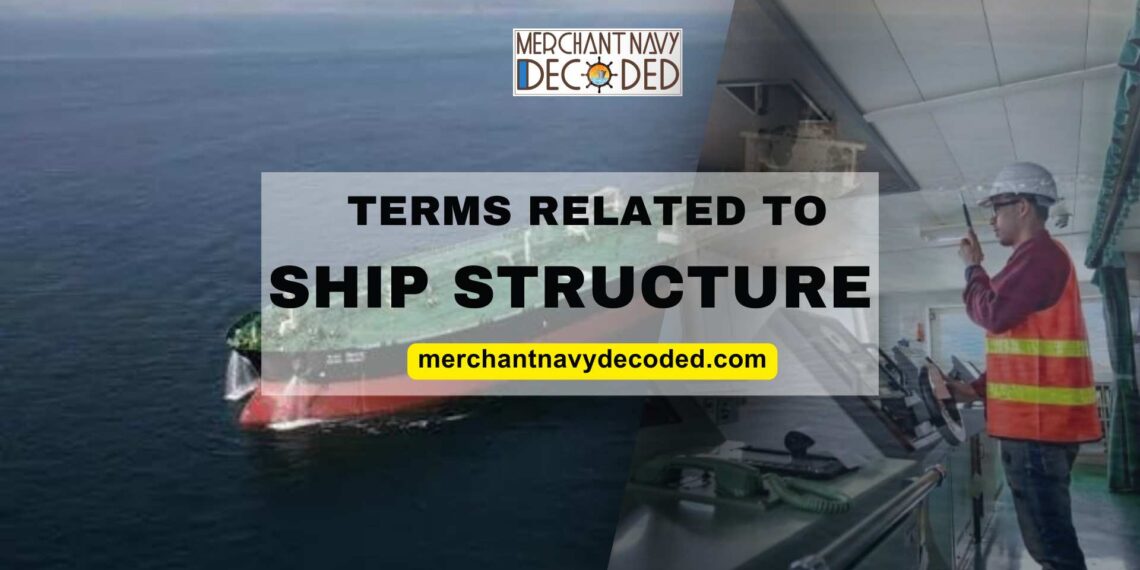Terms Related to Ship Structure
Table of contents
1. Introduction
A ship is a highly advanced piece of technology made up of many parts that work together smoothly. It plays a crucial role in supporting both life and the global economy. Just like every other thing, some names and terms define these structures on the ship from Forward to Aft we are going to learn about the different types of structure, their names, and their significance on the ship.
To get more such information regarding the deck side of a ship like ship stability, ship construction, colregs, etc visit our DECK DREAMER package.
2. Hull
It is the watertight enclosed structure of the ship that protects the cargo, machinery, and accommodation spaces from weather, flooding, and structural damage.
The hull is the main floating body of the vessel that contributes to the vessel’s buoyancy and keeps the vessel afloat by displacing the water, as explained in Archimedes’s principle.
The hull of a vessel can be subdivided into three regions:
- Fore part – It is the forward part of the hull situated at or towards the bow of a vessel (end of the stem).
- Midship – It is the middle part of the hull residing between the forward and aft perpendicular.
- Aft part – It is the rear section or back end of the vessel. The aft part is sometimes also known as the stern of the vessel(end of the stern). Aft is the part underside of which you will find the rudder, propeller, and engine compartment.

3. Fore and Aft Line
Any line that runs lengthwise in the ship. The line joining the middle of the bow and middle of the stern i.e. fore-and-aft centreline. It is an imaginary line passing from stem to stern through the center of the vessel
4. Port and Starboard
A Vertical plane passing through the fore and aft line divides the ship into two sides:-
- Port
- Starboard
When facing the bow, the starboard is on the right side and the port is on the left side

5. Hull Structures
5.1 Keel
It is the main structural part and backbone of the ship. It is the lowermost part of the ship where the sides of the hull as port or starboard meet the bottom of the ship.
5.2 Bow
The bow is the forwardmost part of the ship hull, designed to cut through the water as the vessel moves. In addition, the bow reduces the resistance and ensures smooth navigation of the vessel. The benefits of the bow include improved fuel efficiency, increased speed, and better overall stability.
6. Waterline

The topmost level of the water touches the outer body of the ship. A waterline can also be defined as the special marking on the ship’s hull also known as Plimsoll line or International load line. It indicates the maximum depth to which the vessel can be immersed when loaded with cargo. This depth can vary with ship dimensions, type of cargo, and water density in certain regions.
The surface which is above the waterline is called the ship’s side
The surface which is below the waterline is called the bottom.
7. Terms applied to Hull

7.1 Freeboard
A freeboard is the distance between the waterline and the main deck of a vessel. It is the distance between the uppermost deck considered fully watertight and the official load line.
7.2 Draught
It is a technical term used to determine the distance between the surface of the water and the keel of the vessel.
8. Type of Decks
A deck as we know is a continuous horizontal surface in a vessel. Decks mainly define tier and level on vessels.
8.1 Weather deck
According to (SOLAS), a weather deck can be defined as a deck that is exposed to weather from above or at least two sides.
8.2 Forecastle deck
Forecastle, also known as “fo’c’sle,” is the forward part of the ship’s upper deck found at the front part of the vessel. It is a deck used for the storage of anchors and other equipment i.e. winches and windlass.
8.3 Poopdeck
Poop decks are the superstructures that contain the cabin roof in the rear, or stern of a vessel. It extends from the main deck by a few feet. This is also known as the stern deck on sailing vessels.

9. Terms defining Directions

9.1 Ahead
A longitudinal direction towards the bow of the vessel.
9.2 Astern
A longitudinal direction toward the stern of a vessel.
9.3 Abeam
A perpendicular direction that is straight out from the middle of the vessel on either side
- When the object is midway between ahead and abeam it is said to be on bow
- When the object is midway between astern and abeam it is said to be on quarter
The direction from one side of the ship to the other, at a right angle to the fore and aft line ( port and starboard directing) explains a bit more
10. Terms related to the Ship
10.1 Breadth
Breadth onboard can be defined into two types:- Extreme Breadth & Moulded Breadth.
Extreme breadth
The maximum beam of the vessel is measured from the outside edge of the vessel plating on either side of the ship.
Moulded breadth
Moulded Breadth is measured between the inside edge of the shell plating and hence it is always less than Extreme Breadth.
10.2 Camber
The curvature of the deck in the athwartship direction (round of beam). Compare the height of the deck at the center to the height of the deck at the side of the vessel.
10.3 Depths
Just like the breadth, the depth of the ship is also divided into two sections:- Moulded Depth and Extreme Depth.
Extreme depths
Extreme depth is the distance from the bottom of the keel to the top of the deck beam. (Measurement is taken at the side of the vessel.)
Moulded depth
The moulded depth is measured from the top side of the keel to the top of the deck beam of a ship.
10.4 Sheer
Sheer is defined as a curvature of the deck in the longitudinal direction. (The height of the deck at midship and height of the deck at extreme point are considered)
10.5 Flare
The outward curvature of shell plating at the foremost part of the vessel. It provides extra breadth to the vessel and prevents water from coming onboard.
10.6 Tumblehome
Tumblehome is the narrowing curvature of the vessel above the waterline. The main purpose of the tumblehome is to minimize the center of gravity of the vessel above the waterline.
10.7 Rise of Floor (Deadrise)
The amount by which the line of the outer bottom plating amidship rises above the baseline is called rise of floor.
11. Conclusion
In summary, understanding the terminology related to a vessel is like learning the language of the sea. It empowers individuals to work confidently on a ship by facilitating effective communication, enhancing navigation skills, promoting safety awareness, and ensuring a thorough understanding of the ship’s structure and operations.
Disclaimer :- The opinions expressed in this article belong solely to the author and may not necessarily reflect those of Merchant Navy Decoded. We cannot guarantee the accuracy of the information provided and disclaim any responsibility for it. Data and visuals used are sourced from publicly available information and may not be authenticated by any regulatory body. Reviews and comments appearing on our blogs represent the opinions of individuals and do not necessarily reflect the views of Merchant Navy Decoded. We are not responsible for any loss or damage resulting from reliance on these reviews or comments.
Reproduction, copying, sharing, or use of the article or images in any form is strictly prohibited without prior permission from both the author and Merchant Navy Decoded.





